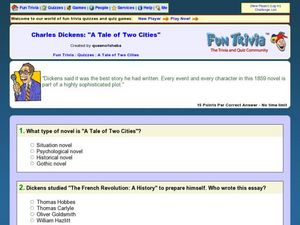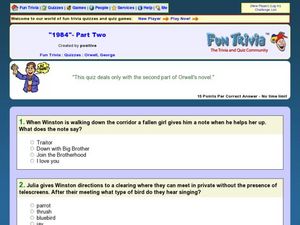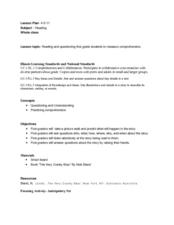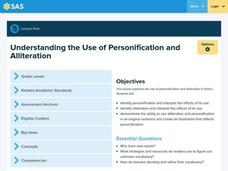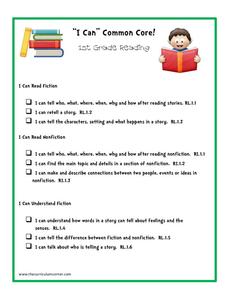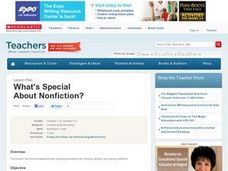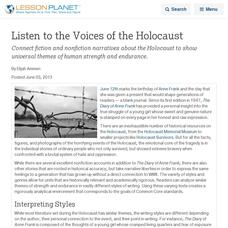Curated OER
Charles Dickens: A Tale of Two Cities
Twenty questions challenge the reader of A Tale of Two Cities. Moving beyond mere reading comprehension, this quiz looks at biographical information and writing style as well as plot structure and action. Use at the end of the novel as a...
Curated OER
1984 - Part Two
Focus on the second half of George Orwell's 1984 with this reading comprehension quiz. All multiple-choice, the questions center on major events in the novel.
Curated OER
Haunted House
Read alouds are great ways to build fluency, accuracy, and intonation. Each slide contains part of a story about a haunted house and audio of the story being read aloud by several different children. Whether you use it as a reading...
Curated OER
In The Shadow of the Pines: Sugar Cane Time
This resource provides a short reading passage, an excerpt from In The Shadow of the Pines by Karen K. Newell, about a family and their sugar cane harvest during the Great Depression. After the reading, there are four multiple choice...
Curated OER
After: A Study of Individual Rights
Use the dystopian novel After by Francine Prose to spark discussion about individual and student rights. Learners read the novel, evaluating how far a school can go to control its attendees. As they read, scholars...
Curated OER
Lesson Plan 7: The Elements of Story
Budding novelists work on character development by relating to the characters in their stories. They imagine their own hopes and dreams and recall those of characters from books they've read. Learners also consider struggles the...
Curated OER
Introduce Vocabulary: Peter's Chair (Keats)
A new baby means a lot of changes for Peter! Ezra Jack Keats presents this common childhood experience in his story Peter's Chair, the context of a detailed vocabulary study. Before you read, introduce the three new words scholars...
Curated OER
Cloze Procedure for Fever 1793 by Laurie Halse Anderson
Is your class ready to read Laurie Halse Anderson's Fever 1793? Before they begin this historical novel, have them complete this cloze procedure to determine if it is at the correct reading level. The directions for introducing a cloze...
Curated OER
Measuring Comprehension in First Graders
Make a prediction! Read The Very Cranky Bear with your first graders, making predictions and asking questions. Consider creating a list of comprehension questions to post while readers are listening to the story. Also consider...
Curated OER
Review of Personification and Alliteration
Learners review personification and alliteration. For this literary devices lesson, students use personification and alliteration in a sentence. Learners draw a picture reflecting personification.
Curated OER
Writing Skills: Fables
Use fables as a fun way for English Language Learners to gain confidence and fluency in their reading and speaking skills. After reading a fable in class, they retell their story to a group of their peers. When this jigsaw activity is...
Curated OER
“I Can” Common Core! 1st Grade Reading
I can read and understand fiction and nonfiction texts! Here is a great checklist that highlights 19 first grade Common Core reading standards. The resource is three pages long. Pages one and two focus on comprehension for fiction and...
Curated OER
What's Special About Nonfiction?
Young scholars examine the difference between nonfiction and fictional writing. They identify the characteristics of nonfiction literature and examine how a nonfiction textbook organizes information.
Louisiana Department of Education
Fahrenheit 451
In his 2013 introduction to Fahrenheit 451, Neil Gaiman states, “Fiction is a lie that tells us true things, over and over.” In this extraordinary unit plan, readers "explore the power of written language to educate and...
National Library of Medicine
Electricity, Frankenstein, and the Spark of Life
Shocking! After viewing a short clip from the 1931 movie, Frankenstein and reviewing electricity references in Mary Shelley's novel, class members examine Luigi Galvani's and Alessandro Volta's observations on electricity and muscle...
Curated OER
The Holocaust in Literature: Fiction and Non-Fiction
Using literature is an effective way to address the Holocaust with your students.
Curated OER
Ego Trip- Exploring the Inner Workings of the Human Body
Students gain an understanding of how systems and organs in the human body work. They create their own fictional account of a trip through the human body, and describe one response the body makes to stimuli.
Curated OER
The Tale of Peter Rabbit
Wow! Here is a most-impressive series of lessons and activities that revolve around the classic story, The Tale of Peter Rabbit. The purpose of the lessons are to provide an agricultural theme in the reading, writing, and science...
Curated OER
American Colonial Life in the Late 1700s: Distant Cousins
Students research how early colonists lived. They investigate late 17th century colonist's lives from Massachusetts and Delaware. Using their research, students write historical fiction in the form of friendly letters between the two...
Curated OER
Under the Sea
Students imagine and describe fictitious sea animals that might live in the ocean. After reading an article, they reflect on new discoveries found in the ocean recently. Using the internet, they research the interdependence of animals...
Curated OER
Listen to the Voices of the Holocaust
Connect fiction and nonfiction narratives about the Holocaust to show universal themes of human strength and endurance.
Curated OER
Civil Disobedience from Antigone to Hunger Games
Study the concepts and practice of civil disobedience through fiction and nonfiction texts.
Curated OER
Historical Fiction: Persuasive Presentation
Fifth graders read a book addressing a specific historical time period that was chosen by their working group. They complete journal entries as they read the book. They create a group PowerPoint explaining the personal point of view and...
Curated OER
Midnight Ride of Paul Revere: Fact, Fiction, and Artistic License
Students examine The Midnight Ride of Paul Revere. In this visual arts instructional activity, students study the historical significance of the event as they examine the Grant Wood painting and primary sources regarding the event.
Other popular searches
- Non Fiction
- Historical Fiction
- Science Fiction
- Non Fiction Text Features
- Realistic Fiction
- Fiction and Nonfiction
- Elements of Fiction
- Fiction or Nonfiction
- Non Fiction
- Fictional Narrative
- Non Fiction Writing
- Teaching Historical Fiction
